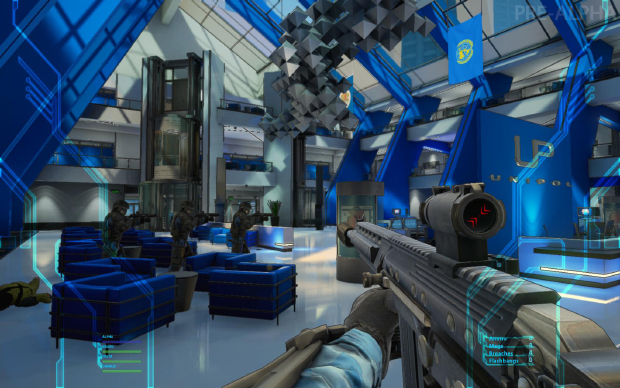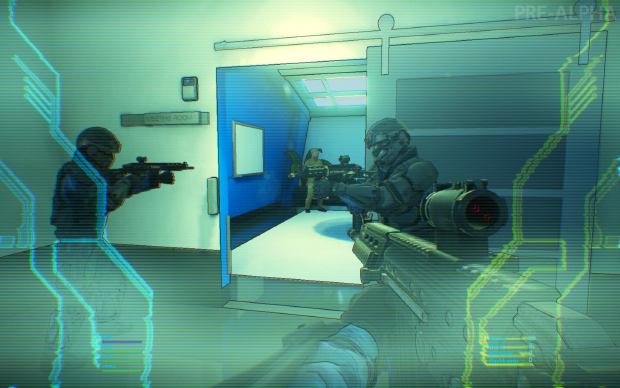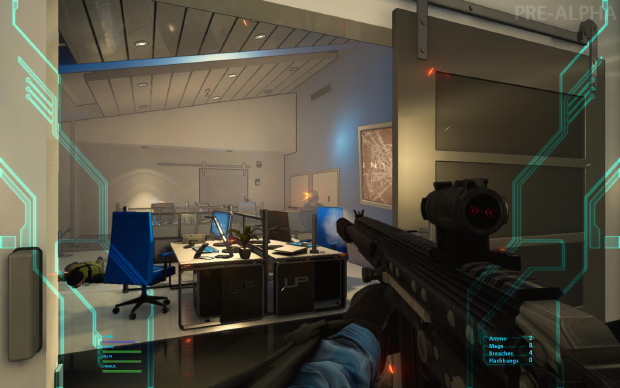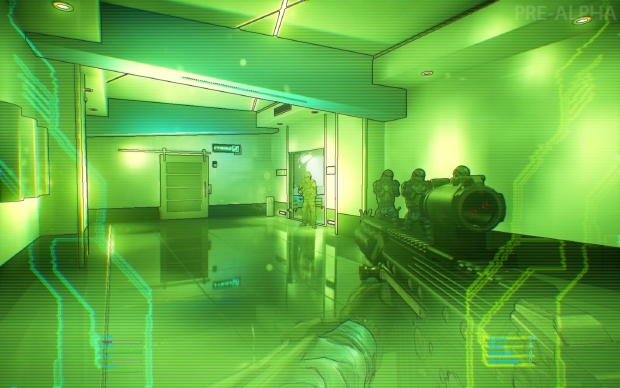Premature Evaluation: Epsilon
Siege mentality
Each week Marsh Davies kicks down the door of Early Access and checks the corners for stories and/or blinds himself with his own flash grenade. But not this week, as flash grenades are not yet a working feature of the pre-alpha Epsilon, a tactical shooter in which you struggle to guide a team of exceptionally inert anti-terrorists using a mixture of pre-planned waypoints and firstperson action.
Epsilon’s bringing the tactical shooter back! As a devotee of a certain era of Tom Clancy games, I’m delighted. Not, you understand, latterday Pulp Someone’s Face With A Piano For The Sake of America Tom Clancy. Not the late-2000’s CGI Fistbump Over The Bodies Of A Thousand Mexican Dead Tom Clancy, either. But early Clancy, with tense, dense, small-scale sieges orchestrated through meticulous pre-mission planning: the tactical shooter as epitomised by Rainbow Six. After many wayward years, Clancy-franchise-owners Ubisoft are overseeing something of a return to their roots too, with the forthcoming Rainbow Six Siege recalling the size if not the pace of those engagements, and Ghost Recon Wildlands bringing back the open environments and varied approaches of the best games of that series, too, before it trammelled itself in grovelling supplication to Call of Duty. (And, while we’re at it, here’s hoping Clint Hocking will give us another Chaos Theory.) But the plucky indie Epsilon, with its waypointed squad commands, perhaps hopes to be even more faithful than these.
Only, Epsilon’s claim feels rather familiar, doesn’t it? In fact, it was what the developers said of their last game, Takedown: Red Sabre, which was not received with overwhelming warmth by the Steam Community. Since then, an issue with Takedown's publisher has led the devs to go back to the drawing board to sketch up a new franchise. While I’m eager to give the five-man dev-team a second chance, currently it feels like they’ve barely put pen to paper. Though they clearly caveat the project’s state as a work in progress, their development roadmap pegs the current completion at a generous 30%. I don't doubt that this is true, but perhaps that 30% has been spread invisibly thin across features that do not yet cohere into a persuasive whole. This is no vertical slice: a brief comic-book introduction serves up a single mission hampered by a host of showstopping bugs and absent of some of its most elementary features, including consistently functional AI. It’s reassuring, maybe, to find so many of the unresponsive parts of the UI labelled “future feature” as it rather ties the developers into fulfilling that promise, but I can’t help but feel this is altogether too early a release to inspire customer confidence.
After the comic-book panels have breezily outlined the terrorist takeover of Unipol HQ, mission planning begins. A 3D tactical map gives you a ghostly schematic view of the three-storey environment, and though you can’t zoom in upon or rotate this, you can hijack the security feeds to get a better view inside, marking terrorists as you do. Currently, the cameras spin by themselves and reset their position every time you use one - which is entirely annoying - and marking enemies is both finicky and of dubious merit: you get to see their movements on the tactical map thereafter, but only during the planning stage, as they aren’t marked when you come to start the mission.
[Correction: as some have helpfully pointed out in the comments, enemies you've marked on the pre-mission map *do* then appear marked on the in-mission map (but not marked through walls while in firstperson). Their non-appearance is something I double-checked before asserting, but I checked again this morning, and they are now marked. So, apologies.]
At least you have a vague sense of their numbers and likely patrol patterns. Though, I’m not sure the game as it stands is sophisticated enough to reward that knowledge with any tactical advantage - there aren’t individualised commands for your squadmates, and so it is impossible to set up scenarios in which your AI minions pincer foes from multiple angles, or one draws their fire while another flanks them. You can place waypoints on the map for the rest of your team to follow as a group, moving to each in turn whenever you tap Z, but this itself becomes a rapidly unworkable means of control. The waypoints lack the detailed instruction of something like Frozen Synapse - you can’t even control the way they face, or determine their stance, and they won’t know how to deal with doors or any other obstacles. If they can’t reach the next waypoint, they improvise with unpredictable and often suicidal results. You can’t undo or remove waypoints (that’s a future feature, along with saving and loading plans) and there’s no option to redraw them when in mission, meaning that any snag will force the abandonment of the plan altogether.
It’s easier to order your men about on the fly - or it would be if your instructions to move forward were guaranteed to inspire your men to any noticeable action whatsoever. But, assuming they do respond, there’s a greater range of expression with the in-mission command system than in the planning stage, allowing your crew to stack up on doors, breach them and clear the rooms behind. This is, in fact, the strategy to use, as doing anything else will get you killed. The AI isn’t astute enough to respond to anything that isn’t directly in front of it, so simply kiting your team around with a follow command doesn’t guarantee they’ll pick targets, even if one such target has just shot you through the temple, mere feet away from them. They don’t have much of a sense of self-preservation, either: my first few attempts at the mission were scuppered by my teammates’ resolution to stoically face a wall while a hail of gunfire pummelled them in the back.
The enemies are no better - bullets can careen around them without risk of incurring their ire, and their friends collapsing dead in front of them appears to be no cause for alarm. But if they do spot you, they will turn and instantaneously shoot you, personally, with nary an animation to delay them. Although you have a large enough health-pool to survive a momentary blast of gunfire, getting shot causes the screen to strobe orange and green, for some reason, making it hard to tell if you are even returning fire. Since your death ends the mission (rather than, say, reassigning your control to a subordinate), it’s better to send your squad in first: they have all the advantages of instantaneous targeting as the enemy AI, but appear to be more lethal with it.
In a building full of small offices, shuffling behind your team as they open doors to one boxy room after the next becomes a little monotonous. But it’s the only way: stack up, enter and clear; stack up, enter and clear; stack up, enter and clear. When you find a hostage, you walk up to them, hold down a button, and somehow, magically, they are “secured”, though there seems to be little appreciable difference in their circumstances. There are suggestions that nuance will follow, of course. Laser trip wires secure certain entrances, though these don’t seem to do anything when triggered yet. An optional objective allows you to disable security systems and unlock doors. Enemies can be forced to surrender with a leg wound, or tasered, rather than simply killed. A sniper can be called in to provide covering fire at a choice of predetermined locations selected during mission planning. There are currently rudimentary equipment choices and the UI suggests that squadmates will at some stage have individual skills and stats. Promising stuff, no doubt, but only promises as yet.
The bright and breezy art-style is a welcome change from the genre’s usual line in gunmetal grit. Unipol HQ seems like a rather delightful place to work when it’s not being shot up: all glossy surfaces, open spaces and saturated blues. But this, and the proposed features above, are gilding on a game in which the necessary basics of tactical instruction are not yet apparent, and in which, critically, the AI is not yet sufficient to articulate a single gun battle without calamity. The hallowed land of Clancydom may be a very long way away whichever route they take, but if I was in charge of the roadmap, I know where I’d want to stop over first.
Epsilon is available from Steam for £5.59, but this price will rise as the project completes over the course of the next year to £25.88. I played version 1.0.4.2 on 16/10/2015.













